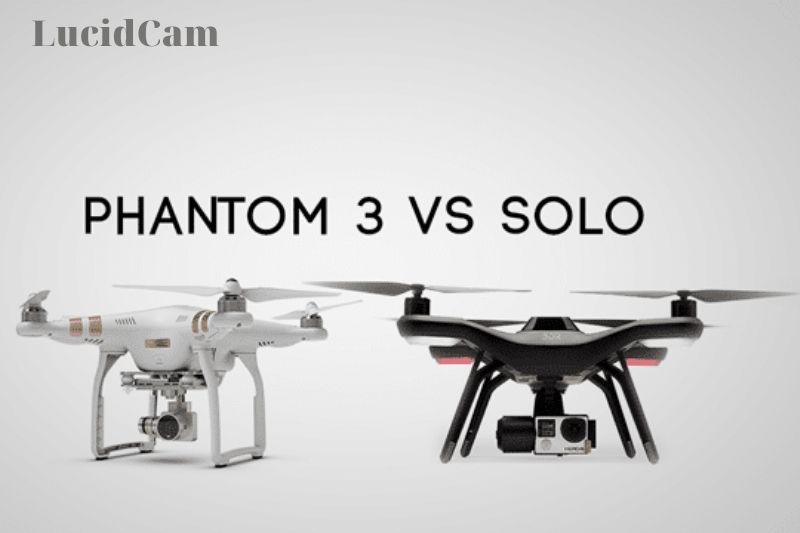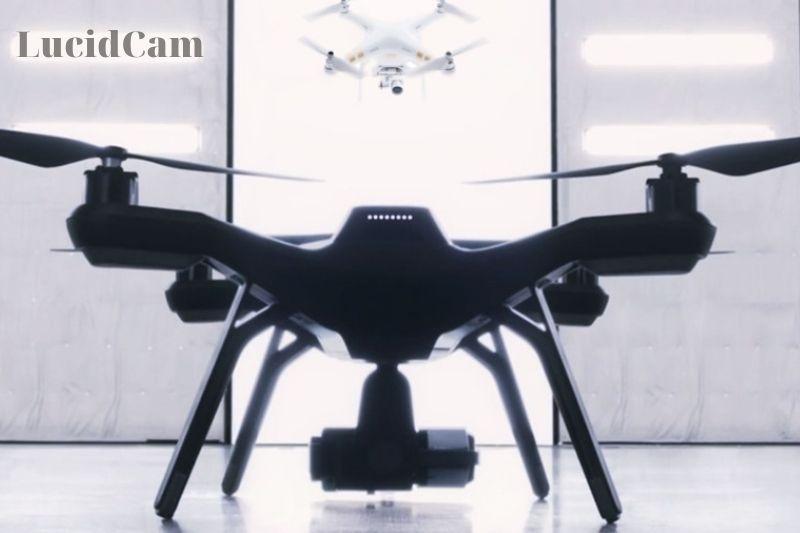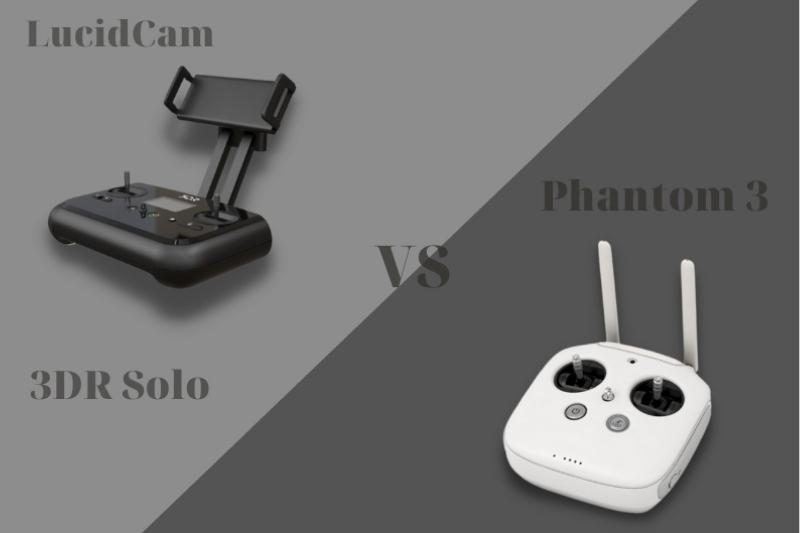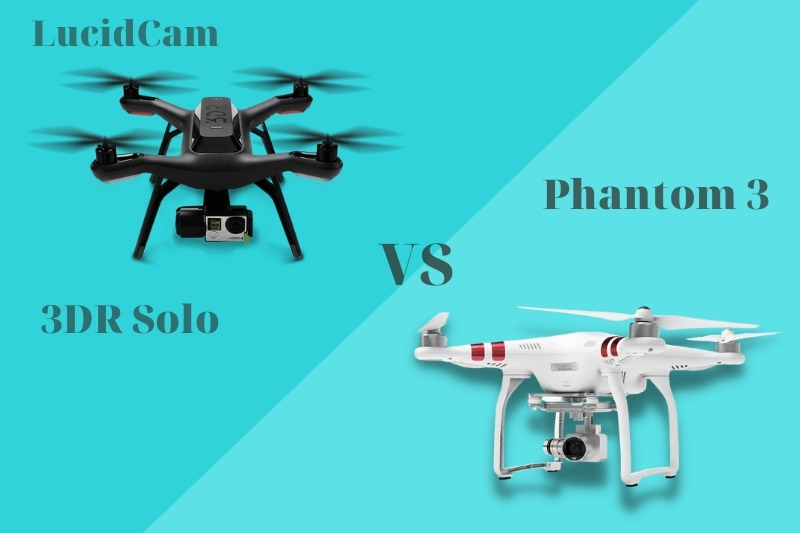Solo Drone Vs Phantom 3, which is the best drone for you? This article will show you the similarities and differences between these two drones as well as how they stack up against their competitors in order to give you a more informed opinion about which one would suit your needs best.
Table of Contents
Solo Drone Vs Phantom 3

3DR Solo
Pros
- Great design
- Fly with ease
- Flys quickly and can be maneuvered easily
- Capable of creating high-quality videos
Cons
- Additional camera (Go Pro required)
- To fly, you will need a smartphone
- Is not equipped with sense-avoid technology
- Charging time is longer than its counterparts
DJI Phantom 3
Pros
- It is extremely stable in the air.
- Flying is easy.
- Smooth 2.7K video capture
- Shooting excellent video
- 20mm wide-angle lens.
- Raw and JPG capture is still possible.
- Intelligent Flight Modes
- Affordable.
- GPS integrated
- Return to your home with function
- Automated takeoffs & landings
Cons
- Propellers invade footage
- It takes over an hour to recharge a battery.
- Requires an Android/IOS device
Aircraft Design

3DR Solo: Stealthy and Open for Upgrades
The Solo’s black stealthy appearance is what many are attracted to. The black Solo looks excellent, and it also stands out against the white clouds. This helps spotters or pilots keep an eye on things. The Solo’s boxy, angular design makes it more useful than a truck, although trucks are still cool.
The Solo’s design is different from the rest of the Solo. 3DR has made Solo an open platform. Accessory attachment points and a removable Gimbal make it possible to upgrade your Gimbal, use third-party hardware, and even create advanced imaging systems and parachutes. 3DR created the “Made for Solo” development program to encourage developers and designers to develop new hardware and software for Solo. This program also gives access to the Solo’s main flight computer. 3DR kept the Solo’s motor pods accessible so that you could add more power to it.
The 3DR Solo is not to be outdone. It comes with its own set features that can compete with the Phantom3. Two 1GHz open-source processors power the bird, as well as HD video streaming capabilities, pre-programmed flight paths, and full GoPro integration.
DJI Phantom3: That Familiar Phantom Look
When it comes to aerial photography drones, this one surely soars to the top of the list. The Phantom 3‘s sleek lines and bright white housing cover the quadcopter design are evident upon the first inspection. Some might find the Phantom 3’s symmetrical footprint more appealing than others. This could also explain why some drone pilots prefer the new Phantom.
The landing gear on the Phantom 3 is slightly different than the 3D robotics Solo. It provides a little more clearance between the camera’s lens and the ground for takeoff and landing. Crossbars on the Phantom’s landing legs serve as handles for calibrating the compass prior to flights. Some pilots also use them to hand launch and catch their Phantoms from the ground. You are responsible for your safety and risk.
Flying Features

3DR Solo: More power, slightly less flight time
The Solo has two 1GHz Linux flight computers. One is located in the cockpit and the other in the controller. This splits computing power to provide a smooth, precise flying experience. The Solo’s GPS, gyros, and accelerometers transmit flight data to the Pixhawk 2 Autopilot System. This allows for smooth flying while filming and rock-solid hovering when taking stills in windy conditions. The Solo’s steady performance in wind conditions is further enhanced by a little weight.
Solo was the first drone with fully automated flight modes, specifically designed for aerial filmmaking. These Smart Shot modes include Cablecam, Orbit, and Selfie. There is also a Follow Me mode, which can lock onto any GPS-enabled device to film you as you run, skateboard, or walk through the city. Smart Shots allow you to let the twin computers fly while you use the remote control to control the camera.
The 3DR Solo’s top speed is 55 mph (89 km/h), which makes it incredibly fun to fly. The Solo also has a “Pause” button that allows you to control your Solo to hover or stop. There is also a Safety Net function, which allows you to set distance and altitude limits to ensure safe beginner flights.
DJI Phantom 3: Simple, Smart, and Sporty
The Phantom 3 has an Intelligent Flight System, an Advanced Internal Measurement Unit, and a 6-axis gyroscope. This will keep you level and under control. Upgraded GPS technology in the Phantom 3 Professional gives you access to at least 36 GPS and GLONASS satellites, which allows for faster link-ups and reliable flight in remote locations.
The Phantom 3 Professional, as well as the new Phantom 4, features a Vision Positioning System similar to SONAR that allows stable indoor flight. This opens up a whole new world of indoor photographic possibilities. However, prop guards are recommended for indoor flying.
Although the Phantom 3 Professional is only 35 mph (57.6 km/h), it’s still faster than the Solo. However, the Intelligent Flight Battery keeps the Phantom 3 Professional in the air for an extra three minutes. This is important when you are taking one-in-a-million photos of the sunset in Hawaii. The battery also recharges faster than the Solo.
DJI recently developed Intelligent Flight Modes, similar to the Solo. This allows you to set your Phantom 3’s flight path to follow you, orbit an object of interest, take amazing fade-away selfies, and even fly along with a series of GPS waypoints. Like Smart Shots, DJI’s Intelligent flight modes let you focus on the camera and dial in stunning stable shots that will captivate your audience.
Camera Features
JDI and 3DR both know that drones can capture stunning aerial photos and videos. Both manufacturers have benefited from this. Both companies put in great effort to make aerial photography fun, intuitive, simple, and enjoyable for users.
Both birds have 4K-capable cameras. 3DR Solo may be a little more precise than the Phantom. The Phantom 3’s camera sensor is identical to that in Inspire 1. While the Phantom 2 Vision+’s gimbal is very similar, the Phantom 3’s is much smaller. This allows you to capture videos and photos with exceptional clarity and quality.
Based on quadcopter reviews, Solo’s video capture function does not appear as smooth as that of the Phantom3 or the Phantom 2. Although the Solo’s technical video quality is excellent, it does not use the GoPro Hero 4. However, stability can be an issue as you may notice shakes and twitches in the videos. Many enthusiasts agree that the 3DR Solo promo video has been digitally stabilized.
One point worth noting is that the Phantom3 comes with a pre-installed gimbal, fixed gimbal. It can only be used with the Phantom 3’s pre-installed camera. The Solo is compatible with other cameras as well as gimbals. This will be up to the pilot.
Both drones can shoot 4K videos at 30fps, and 12MP stills. The Phantom 3 uses the DJI camera included and 3DR Solo via the GoPro Hero 4 Both drones can also stream live HD to a mobile device via their respective apps. The two drones allow the users to stop videos while in flight, which prevents them from trimming via a great deal of unwanted footage. They offer custom control of this camera.
Remote Controller

3DR Solo: HDMI out FTW
3DR has installed a 1GHz computer in the Solo controller. This increases Solo’s processing speed and saves flight data. This can come in handy in the case of a serious crash or flyaway. If you have the data, 3DR will replace both your Solo and your GoPro.
A data screen displays flight data such as altitude, battery status, battery life, altitude, and gimbal angle. This is another obvious distinction. The solo’s controller can be connected to a small tablet or smartphone via Wi-Fi and sent to your 3DR Solo from up to half a mile away.
The 3D robotics Solo controller’s most unique feature is the HDMI port. This allows you to send a 1080p H.D. video stream directly to your T.V. or computer. This tiny feature will allow you to expand your Solo’s capabilities and create a unique flying experience.
Both the Solo and Phantom controllers have the Return and Land at Home buttons, gimbal control, shutter button, and the ability to customize buttons. These useful features are very popular during flight sessions.
DJI Phantom3: Greater Range With Lightbridge
Phantom 3’s controller has the same twin joystick design as its predecessor, but you can now use a full-size tablet to get a bigger live H.D. view of your drone flight. To reduce video lag, it also makes use of DJI’s Lightbridge USB connector to speed up data transfer between the controller and your device.
The Phantom 3 has a transmission range of up to 3.1 miles. However, due to current FAA UAV regulations, drone pilots in the U.S. must keep their drones within reach at all times. This brings the legal (or realistic) range down to about a half-mile, which may not be a significant difference for U.S. drone pilots.
The 3D Robotics Solo has a Pause button on the controller. DJI, however, has the same “stop and hover” command built into its Intelligent Flight System controls. Your Phantom3 hovers until you tell it what you want. Although it is a basic feature, it can help pilots who are new to flying gain confidence and reorient themselves during flight.
Mobile App
DJI and 3DR have done an excellent job in developing apps that enhance the drone flying experience. Both are compatible with Android and iOS and provide live H.D. views at 720p.
3DR Solo
Apart from all the overlap features, Solo App is said to be easier to use right out of the gate, giving users a faster learning curve. Its simpler display is likely due to the fact that most flight data appears on the controller’s LCD screen.
Many drone enthusiasts will find the Solo App’s open-source DroneKit SDK (web API) to be the most appealing feature. This allows users to hack the software and create new apps. This open platform, which is supported by the Dronecode Foundation, allows hobbyists and software developers to create new apps that add functionality to your Solo drone. You can also customize how Solo uploads data to DroneKit Cloud. This is the software component of 3DR’s “Made for Solo” development program. It aims to help small businesses grow and improve Solo and drone technology overall. This could be a great company philosophy for drone enthusiasts.
The Solo app allows you to update all Solo’s firmware wirelessly. It’s much faster than the Phantom3 update process, and you can fly much quicker once an update is available.
Phantom 3: Advanced Settings For Photogs
The DJI Go App offers a wide range of advanced settings for the Phantom3. This is the main selling point. You can quickly adjust ISO, resolution, and frame rate to tune your camera for the conditions. You can stream your flight to YouTube and impress your fans.
DJI also offers app development via the Go App’s SDK. However, it only allows you to create apps that work with your smartphone and not the whole flight system.
HD Video streaming
The DJI Phantom 3 comes in two versions: the professional and advanced versions. The Phantom 3 professional model records at 1080p HD. While the Phantom3 advanced version records at 1080p HD. The Phantom 3 professional edition has a new 4K camera that streams HD video and has a wide array of sensors. Each DJI Phantom 3 version comes with a 12.0MP camera.
The 3DR Solo, on the other hand, is the first smart drone in the world and features a few 1GHz processors, HD Video streaming, GoPro integration, and pre-programmed flight routes.
Video Features
DJI Phantom 3
DJI upgraded the Phantom 3 completely. This baby was equipped with a brand new 4K camera, HD streaming from a mile, and a larger array of sensors. The Phantom 3 is an extremely capable piece of video equipment.
The DJI Phantom 3’s video capabilities are unmatched. The DJI Phantom 3 has a 4K camera that can stream in HD. It also allows live HD streaming of video feeds. (Via YouTube or on your smartphone through APPs for IOS and Android. It is amazing how visible the picture on the DJI Phantom 3. These photos are very clear and accurate.
Solo 3DR
3D Robotics will release the 3DR Solo a little later. They aimed the drone to be a direct rival to the DJI Phantom 3. The 3DR Solo drone is an amazing bird. Just look at it. It is mysterious and black in a certain way. Because it’s so sleek and beautiful, it feels like a spy drone. It does have some perks, however. It comes with two 1GHz processors that run LUNIX. We should also mention that they can fly using pre-programmed flight paths.
We can’t speak for the 3D Robotics Solo. The 3D Robotics Solo’s gimbal tends to shake and twitch, resulting in unclear and inaccurate photos. The 3D Robotics Solo’s camera isn’t terrible. It can record HD Video in 720 HD and can stream live video to your smartphone via the app. The DJI Phantom 3’s are a superior camera, even without the proper accessories. However, the quality of video and images is unmatched.
Price
DJI is the clear winner when it comes to price. Even the more expensive Phantom 3 Professional, which retails at $1,259, comes in under the price of a complete Solo package.
The Solo is only $999 and you can add their gimbal for 399 or a GoPro camera (the Hero 4 for $499). The Phantom 3 Professional package with an additional battery and Phantom backpack costs $1,659. This is a significant increase in price if you need to get 4K capability.
Did you know that Solo had an optical flow built-in?
Yes, optical flow sensors could be seen on Solo at NAB but not on models actually flying (actually, there was only one model that had an optical flow sensor). What does this all mean? Although I am not sure what this means, here are my thoughts.
3D Robotics spoke about adding an optical flow sensor in the expansion bay. But what they didn’t mention was that some models already have an optical flow sensing device.
Although I don’t know the reason they claimed that the sensor wasn’t there on the Solo, I do have a few theories. They might have had trouble getting the optical flow working on Solo in time for launch so they took it out. Maybe there will be a new, more expensive model with more features. It’s not clear why they bring two models to NAB, and I don’t know what it is.
Conclusion
Lucidcam hopes you find this article is helpful and informative. We know it can be hard to choose between drones, so we want to help by giving you the low down on the 3DR solo vs DJI phantom 3! With our simple guide, you’ll have all of your questions answered in no time at all. Thanks for reading, and happy flying!
Read More:
- DJI Phantom 3 Vs 4 2023: Which Is Better For You?
- Phantom 3 Vs Inspire 1: Which Is Better For You?
- DJI Phantom 3 Vs Spark 2023: Which Is Better For You?
- DJI Phantom 3 Pro Vs 4 Pro 2023: Which Is Better For You?
